A Comprehensive Report on International Trade, Finance, and Investment
VerifiedAdded on 2021/01/01
|15
|4032
|419
Report
AI Summary
This report provides a comprehensive overview of international trade and finance, delving into the intricacies of global markets and investment strategies. It examines the key aspects of both domestic and international economies, with a focus on capital allocation within financial markets. The report explores the roles of international organizations such as the WTO and NAFTA in facilitating trade and fostering economic growth. It also evaluates the performance of emerging economies, using India as a case study, and analyzes the challenges and opportunities presented by industrialization and trade policies. The study highlights the significance of financial markets, including banking systems, money markets, and stock exchanges, in driving economic development and facilitating international transactions. It also discusses the importance of international organizations in promoting trade, resolving disputes, and supporting economic development worldwide. Overall, the report offers valuable insights into the complexities and dynamics of international trade and finance, providing a solid understanding of the subject.
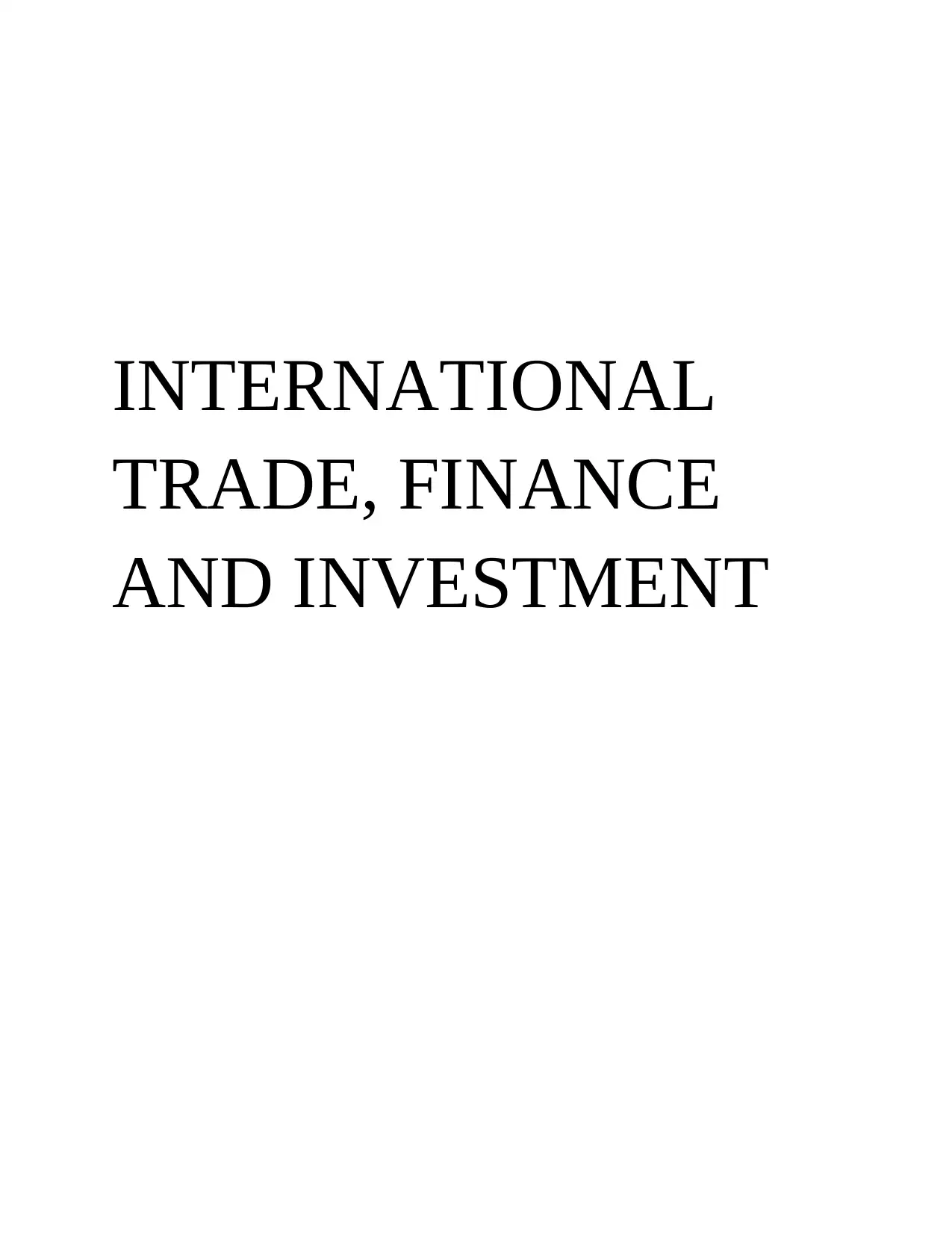
INTERNATIONAL
TRADE, FINANCE
AND INVESTMENT
TRADE, FINANCE
AND INVESTMENT
Paraphrase This Document
Need a fresh take? Get an instant paraphrase of this document with our AI Paraphraser
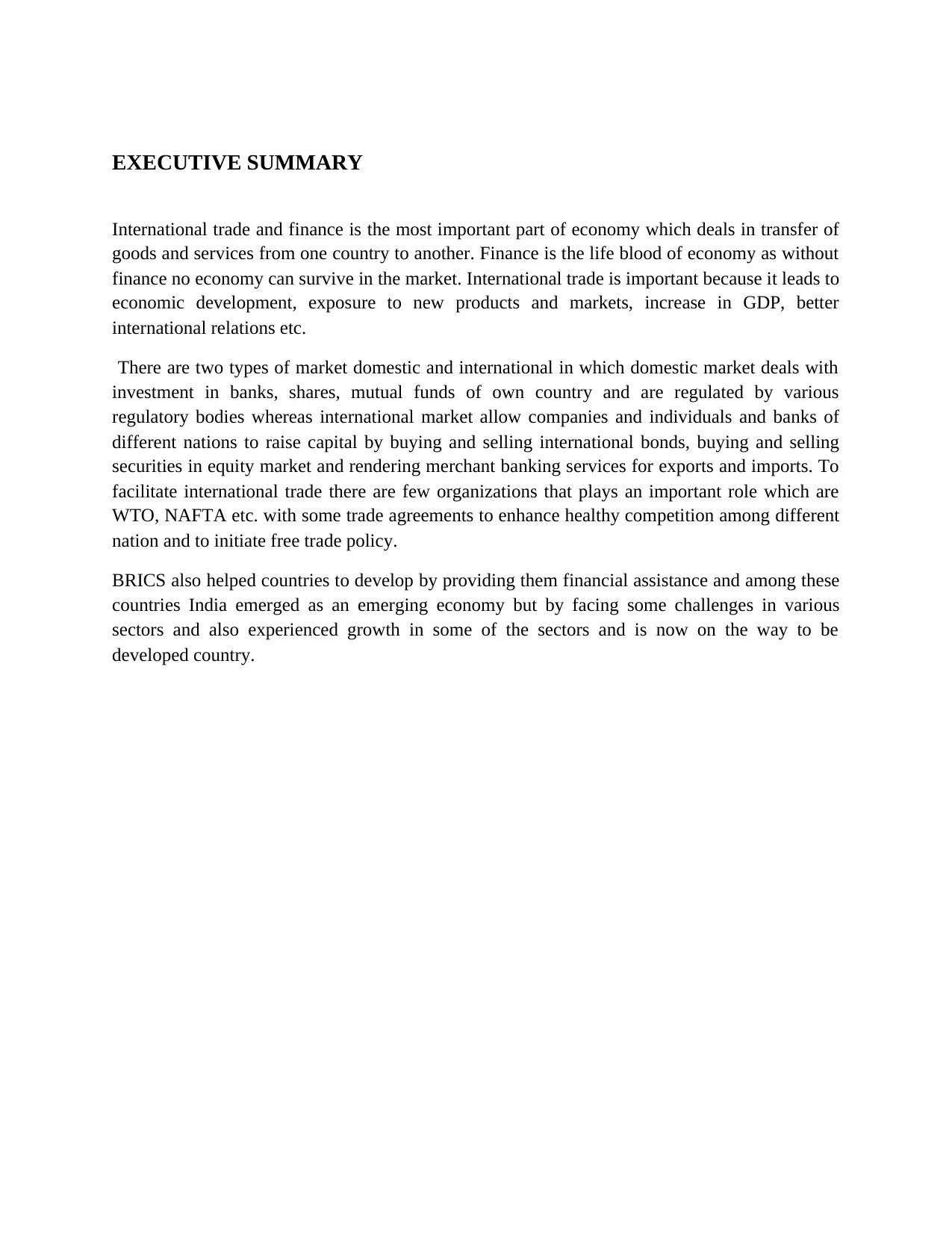
EXECUTIVE SUMMARY
International trade and finance is the most important part of economy which deals in transfer of
goods and services from one country to another. Finance is the life blood of economy as without
finance no economy can survive in the market. International trade is important because it leads to
economic development, exposure to new products and markets, increase in GDP, better
international relations etc.
There are two types of market domestic and international in which domestic market deals with
investment in banks, shares, mutual funds of own country and are regulated by various
regulatory bodies whereas international market allow companies and individuals and banks of
different nations to raise capital by buying and selling international bonds, buying and selling
securities in equity market and rendering merchant banking services for exports and imports. To
facilitate international trade there are few organizations that plays an important role which are
WTO, NAFTA etc. with some trade agreements to enhance healthy competition among different
nation and to initiate free trade policy.
BRICS also helped countries to develop by providing them financial assistance and among these
countries India emerged as an emerging economy but by facing some challenges in various
sectors and also experienced growth in some of the sectors and is now on the way to be
developed country.
International trade and finance is the most important part of economy which deals in transfer of
goods and services from one country to another. Finance is the life blood of economy as without
finance no economy can survive in the market. International trade is important because it leads to
economic development, exposure to new products and markets, increase in GDP, better
international relations etc.
There are two types of market domestic and international in which domestic market deals with
investment in banks, shares, mutual funds of own country and are regulated by various
regulatory bodies whereas international market allow companies and individuals and banks of
different nations to raise capital by buying and selling international bonds, buying and selling
securities in equity market and rendering merchant banking services for exports and imports. To
facilitate international trade there are few organizations that plays an important role which are
WTO, NAFTA etc. with some trade agreements to enhance healthy competition among different
nation and to initiate free trade policy.
BRICS also helped countries to develop by providing them financial assistance and among these
countries India emerged as an emerging economy but by facing some challenges in various
sectors and also experienced growth in some of the sectors and is now on the way to be
developed country.

⊘ This is a preview!⊘
Do you want full access?
Subscribe today to unlock all pages.

Trusted by 1+ million students worldwide
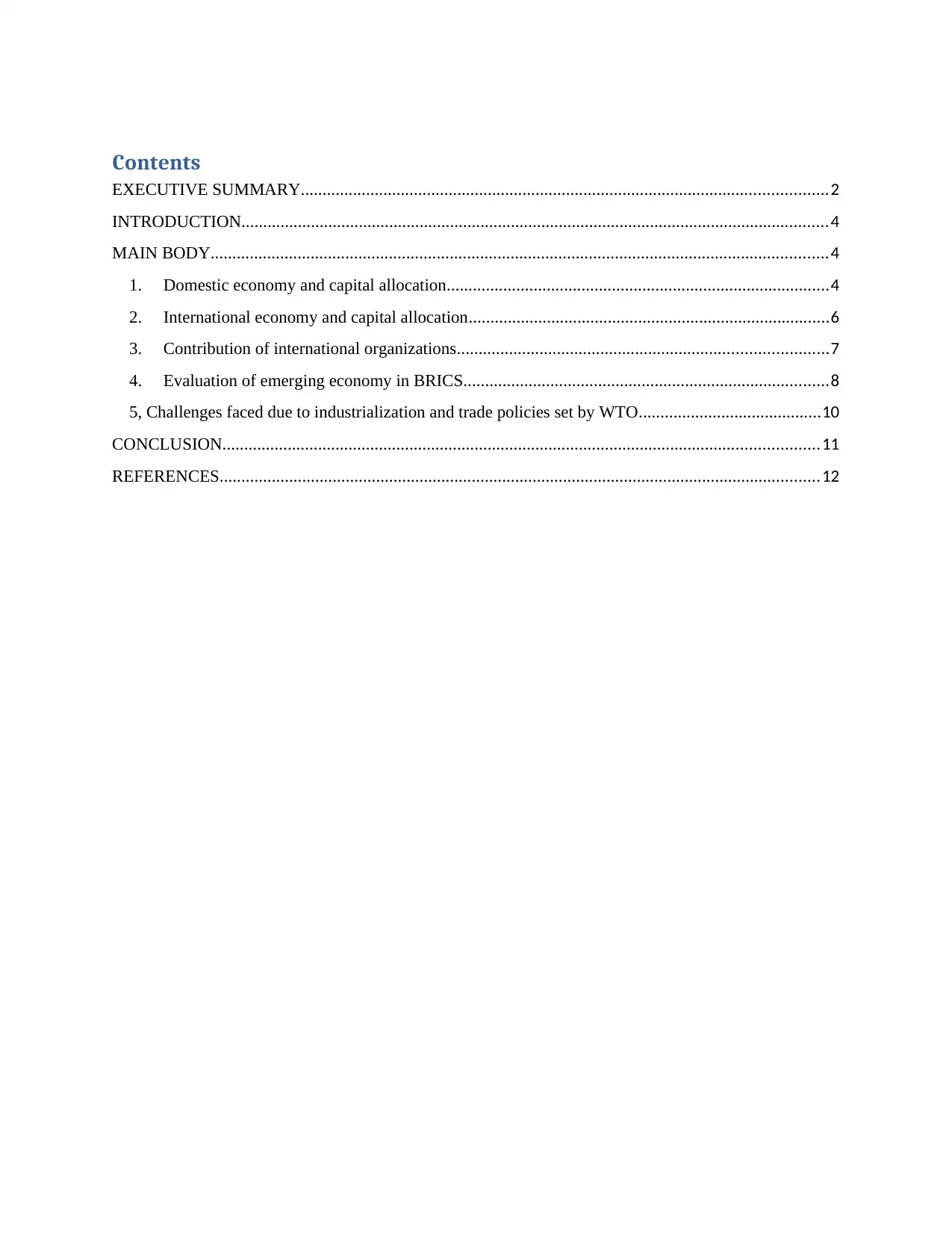
Contents
EXECUTIVE SUMMARY.........................................................................................................................2
INTRODUCTION.......................................................................................................................................4
MAIN BODY..............................................................................................................................................4
1. Domestic economy and capital allocation........................................................................................4
2. International economy and capital allocation...................................................................................6
3. Contribution of international organizations.....................................................................................7
4. Evaluation of emerging economy in BRICS....................................................................................8
5, Challenges faced due to industrialization and trade policies set by WTO..........................................10
CONCLUSION.........................................................................................................................................11
REFERENCES..........................................................................................................................................12
EXECUTIVE SUMMARY.........................................................................................................................2
INTRODUCTION.......................................................................................................................................4
MAIN BODY..............................................................................................................................................4
1. Domestic economy and capital allocation........................................................................................4
2. International economy and capital allocation...................................................................................6
3. Contribution of international organizations.....................................................................................7
4. Evaluation of emerging economy in BRICS....................................................................................8
5, Challenges faced due to industrialization and trade policies set by WTO..........................................10
CONCLUSION.........................................................................................................................................11
REFERENCES..........................................................................................................................................12
Paraphrase This Document
Need a fresh take? Get an instant paraphrase of this document with our AI Paraphraser
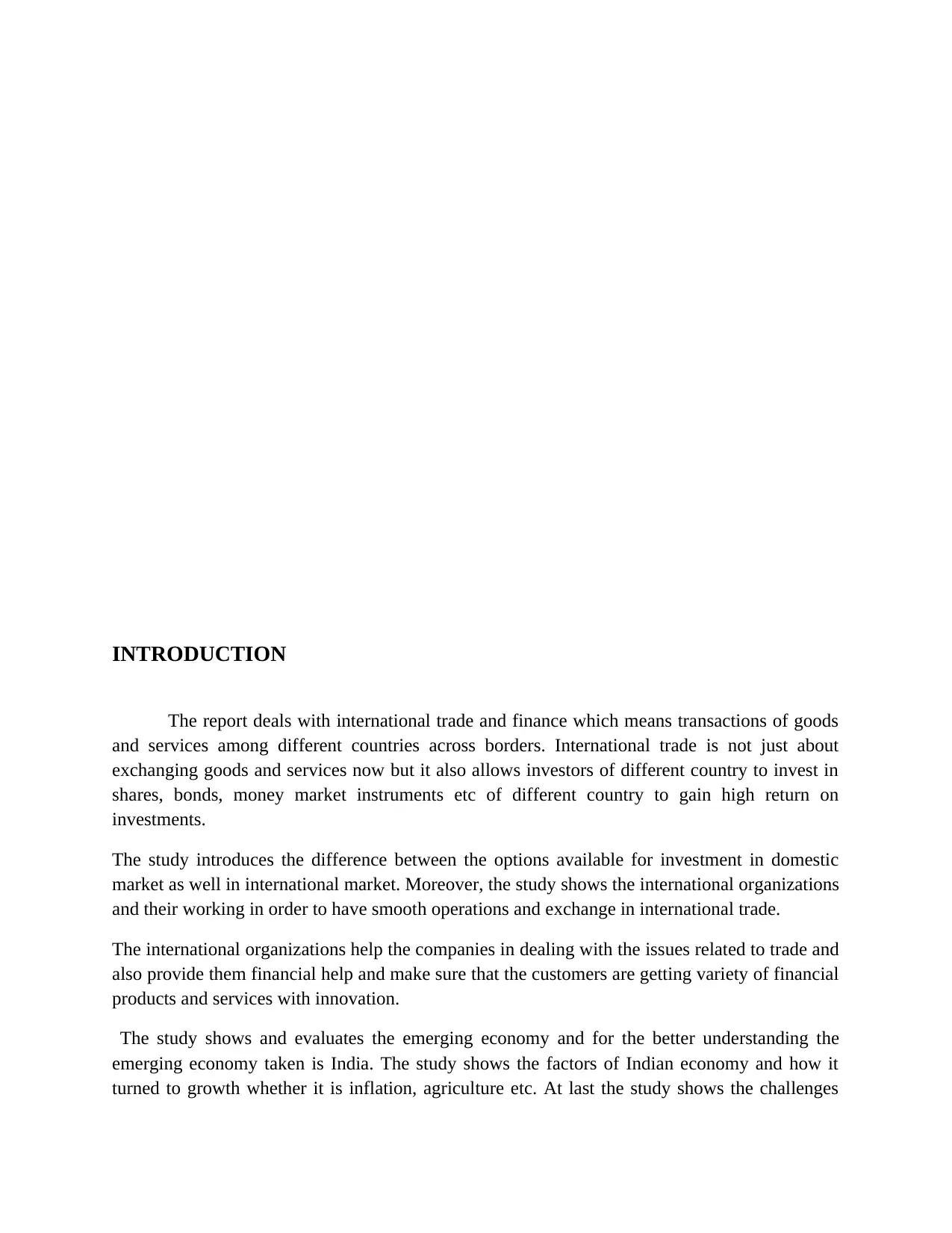
INTRODUCTION
The report deals with international trade and finance which means transactions of goods
and services among different countries across borders. International trade is not just about
exchanging goods and services now but it also allows investors of different country to invest in
shares, bonds, money market instruments etc of different country to gain high return on
investments.
The study introduces the difference between the options available for investment in domestic
market as well in international market. Moreover, the study shows the international organizations
and their working in order to have smooth operations and exchange in international trade.
The international organizations help the companies in dealing with the issues related to trade and
also provide them financial help and make sure that the customers are getting variety of financial
products and services with innovation.
The study shows and evaluates the emerging economy and for the better understanding the
emerging economy taken is India. The study shows the factors of Indian economy and how it
turned to growth whether it is inflation, agriculture etc. At last the study shows the challenges
The report deals with international trade and finance which means transactions of goods
and services among different countries across borders. International trade is not just about
exchanging goods and services now but it also allows investors of different country to invest in
shares, bonds, money market instruments etc of different country to gain high return on
investments.
The study introduces the difference between the options available for investment in domestic
market as well in international market. Moreover, the study shows the international organizations
and their working in order to have smooth operations and exchange in international trade.
The international organizations help the companies in dealing with the issues related to trade and
also provide them financial help and make sure that the customers are getting variety of financial
products and services with innovation.
The study shows and evaluates the emerging economy and for the better understanding the
emerging economy taken is India. The study shows the factors of Indian economy and how it
turned to growth whether it is inflation, agriculture etc. At last the study shows the challenges
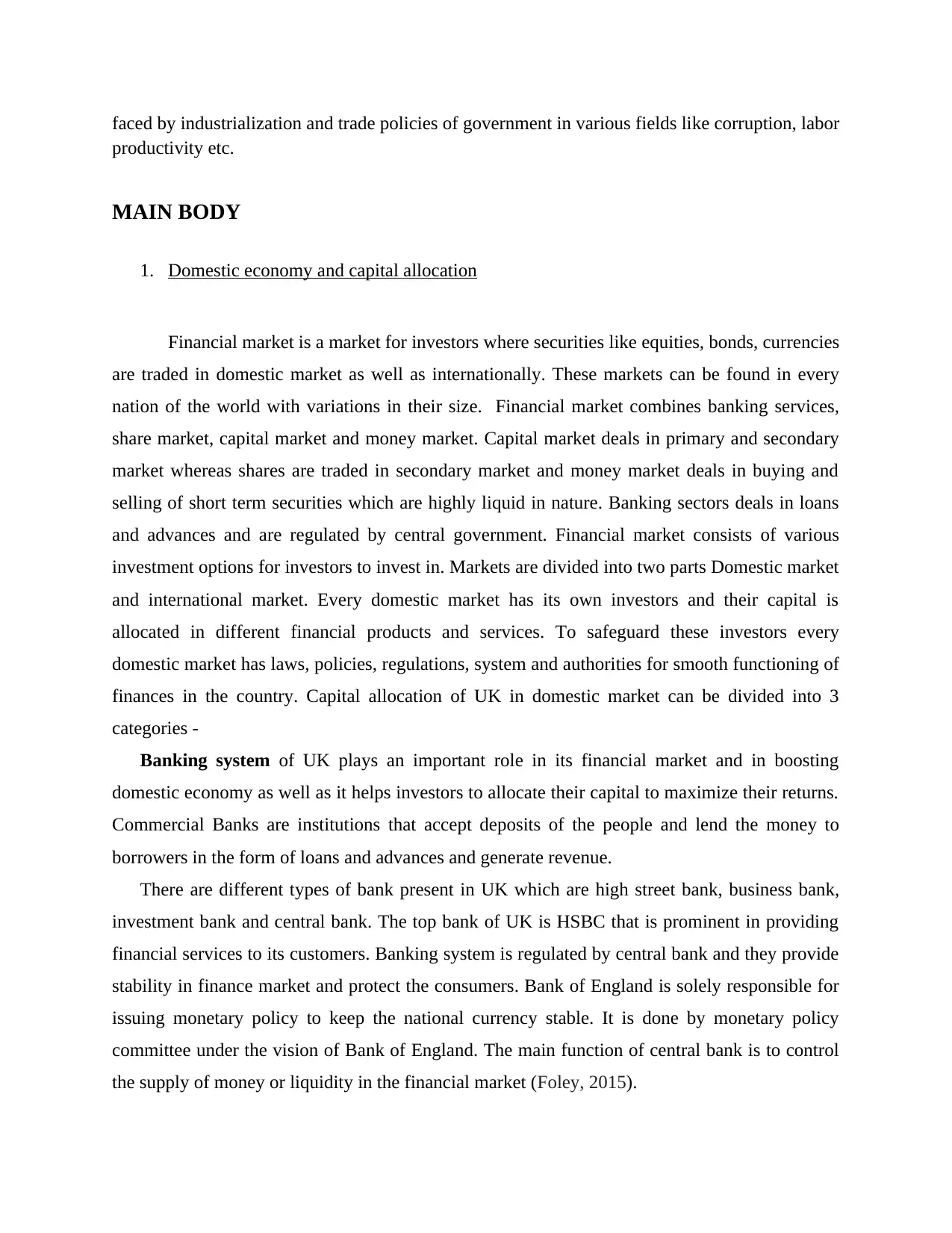
faced by industrialization and trade policies of government in various fields like corruption, labor
productivity etc.
MAIN BODY
1. Domestic economy and capital allocation
Financial market is a market for investors where securities like equities, bonds, currencies
are traded in domestic market as well as internationally. These markets can be found in every
nation of the world with variations in their size. Financial market combines banking services,
share market, capital market and money market. Capital market deals in primary and secondary
market whereas shares are traded in secondary market and money market deals in buying and
selling of short term securities which are highly liquid in nature. Banking sectors deals in loans
and advances and are regulated by central government. Financial market consists of various
investment options for investors to invest in. Markets are divided into two parts Domestic market
and international market. Every domestic market has its own investors and their capital is
allocated in different financial products and services. To safeguard these investors every
domestic market has laws, policies, regulations, system and authorities for smooth functioning of
finances in the country. Capital allocation of UK in domestic market can be divided into 3
categories -
Banking system of UK plays an important role in its financial market and in boosting
domestic economy as well as it helps investors to allocate their capital to maximize their returns.
Commercial Banks are institutions that accept deposits of the people and lend the money to
borrowers in the form of loans and advances and generate revenue.
There are different types of bank present in UK which are high street bank, business bank,
investment bank and central bank. The top bank of UK is HSBC that is prominent in providing
financial services to its customers. Banking system is regulated by central bank and they provide
stability in finance market and protect the consumers. Bank of England is solely responsible for
issuing monetary policy to keep the national currency stable. It is done by monetary policy
committee under the vision of Bank of England. The main function of central bank is to control
the supply of money or liquidity in the financial market (Foley, 2015).
productivity etc.
MAIN BODY
1. Domestic economy and capital allocation
Financial market is a market for investors where securities like equities, bonds, currencies
are traded in domestic market as well as internationally. These markets can be found in every
nation of the world with variations in their size. Financial market combines banking services,
share market, capital market and money market. Capital market deals in primary and secondary
market whereas shares are traded in secondary market and money market deals in buying and
selling of short term securities which are highly liquid in nature. Banking sectors deals in loans
and advances and are regulated by central government. Financial market consists of various
investment options for investors to invest in. Markets are divided into two parts Domestic market
and international market. Every domestic market has its own investors and their capital is
allocated in different financial products and services. To safeguard these investors every
domestic market has laws, policies, regulations, system and authorities for smooth functioning of
finances in the country. Capital allocation of UK in domestic market can be divided into 3
categories -
Banking system of UK plays an important role in its financial market and in boosting
domestic economy as well as it helps investors to allocate their capital to maximize their returns.
Commercial Banks are institutions that accept deposits of the people and lend the money to
borrowers in the form of loans and advances and generate revenue.
There are different types of bank present in UK which are high street bank, business bank,
investment bank and central bank. The top bank of UK is HSBC that is prominent in providing
financial services to its customers. Banking system is regulated by central bank and they provide
stability in finance market and protect the consumers. Bank of England is solely responsible for
issuing monetary policy to keep the national currency stable. It is done by monetary policy
committee under the vision of Bank of England. The main function of central bank is to control
the supply of money or liquidity in the financial market (Foley, 2015).
⊘ This is a preview!⊘
Do you want full access?
Subscribe today to unlock all pages.

Trusted by 1+ million students worldwide
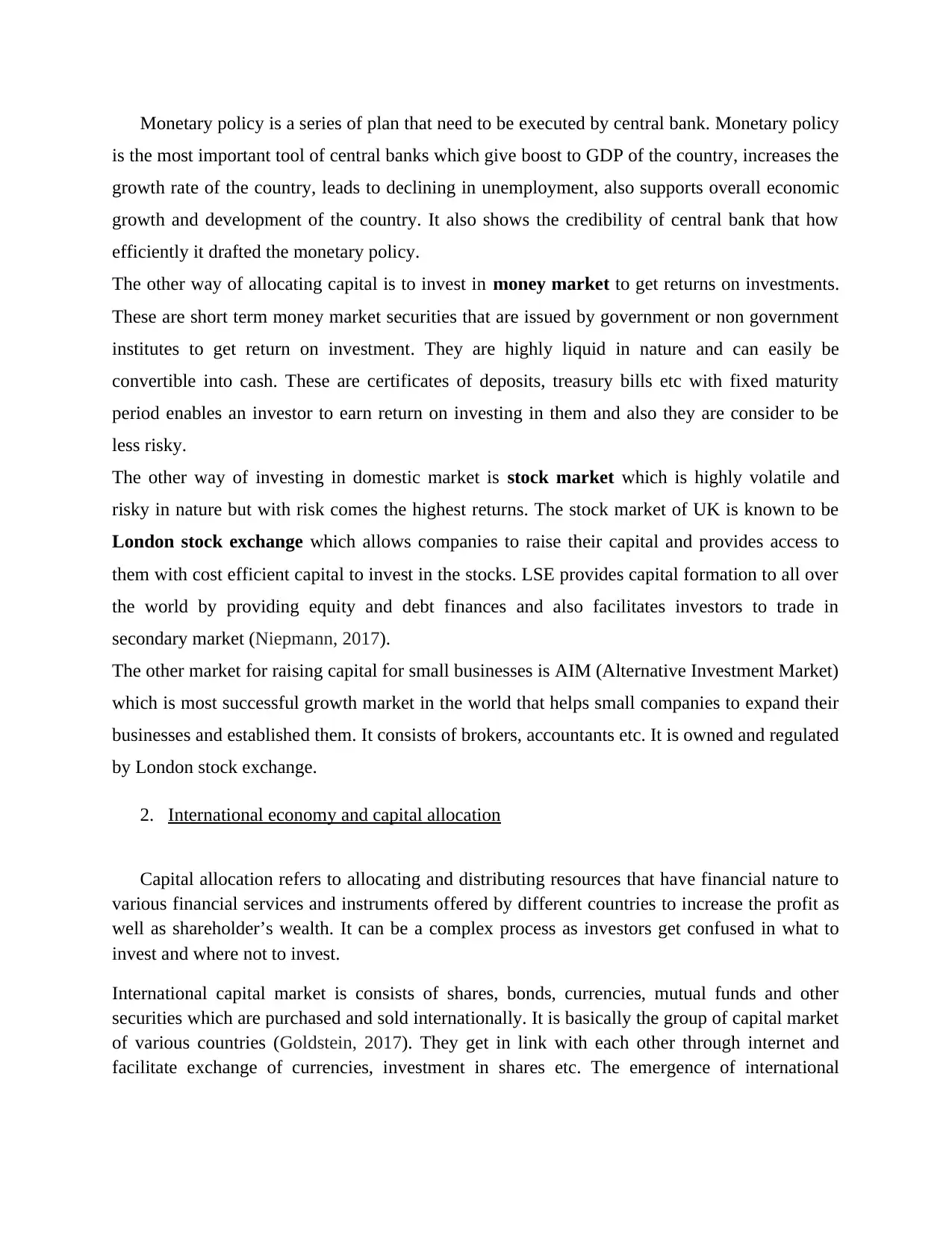
Monetary policy is a series of plan that need to be executed by central bank. Monetary policy
is the most important tool of central banks which give boost to GDP of the country, increases the
growth rate of the country, leads to declining in unemployment, also supports overall economic
growth and development of the country. It also shows the credibility of central bank that how
efficiently it drafted the monetary policy.
The other way of allocating capital is to invest in money market to get returns on investments.
These are short term money market securities that are issued by government or non government
institutes to get return on investment. They are highly liquid in nature and can easily be
convertible into cash. These are certificates of deposits, treasury bills etc with fixed maturity
period enables an investor to earn return on investing in them and also they are consider to be
less risky.
The other way of investing in domestic market is stock market which is highly volatile and
risky in nature but with risk comes the highest returns. The stock market of UK is known to be
London stock exchange which allows companies to raise their capital and provides access to
them with cost efficient capital to invest in the stocks. LSE provides capital formation to all over
the world by providing equity and debt finances and also facilitates investors to trade in
secondary market (Niepmann, 2017).
The other market for raising capital for small businesses is AIM (Alternative Investment Market)
which is most successful growth market in the world that helps small companies to expand their
businesses and established them. It consists of brokers, accountants etc. It is owned and regulated
by London stock exchange.
2. International economy and capital allocation
Capital allocation refers to allocating and distributing resources that have financial nature to
various financial services and instruments offered by different countries to increase the profit as
well as shareholder’s wealth. It can be a complex process as investors get confused in what to
invest and where not to invest.
International capital market is consists of shares, bonds, currencies, mutual funds and other
securities which are purchased and sold internationally. It is basically the group of capital market
of various countries (Goldstein, 2017). They get in link with each other through internet and
facilitate exchange of currencies, investment in shares etc. The emergence of international
is the most important tool of central banks which give boost to GDP of the country, increases the
growth rate of the country, leads to declining in unemployment, also supports overall economic
growth and development of the country. It also shows the credibility of central bank that how
efficiently it drafted the monetary policy.
The other way of allocating capital is to invest in money market to get returns on investments.
These are short term money market securities that are issued by government or non government
institutes to get return on investment. They are highly liquid in nature and can easily be
convertible into cash. These are certificates of deposits, treasury bills etc with fixed maturity
period enables an investor to earn return on investing in them and also they are consider to be
less risky.
The other way of investing in domestic market is stock market which is highly volatile and
risky in nature but with risk comes the highest returns. The stock market of UK is known to be
London stock exchange which allows companies to raise their capital and provides access to
them with cost efficient capital to invest in the stocks. LSE provides capital formation to all over
the world by providing equity and debt finances and also facilitates investors to trade in
secondary market (Niepmann, 2017).
The other market for raising capital for small businesses is AIM (Alternative Investment Market)
which is most successful growth market in the world that helps small companies to expand their
businesses and established them. It consists of brokers, accountants etc. It is owned and regulated
by London stock exchange.
2. International economy and capital allocation
Capital allocation refers to allocating and distributing resources that have financial nature to
various financial services and instruments offered by different countries to increase the profit as
well as shareholder’s wealth. It can be a complex process as investors get confused in what to
invest and where not to invest.
International capital market is consists of shares, bonds, currencies, mutual funds and other
securities which are purchased and sold internationally. It is basically the group of capital market
of various countries (Goldstein, 2017). They get in link with each other through internet and
facilitate exchange of currencies, investment in shares etc. The emergence of international
Paraphrase This Document
Need a fresh take? Get an instant paraphrase of this document with our AI Paraphraser
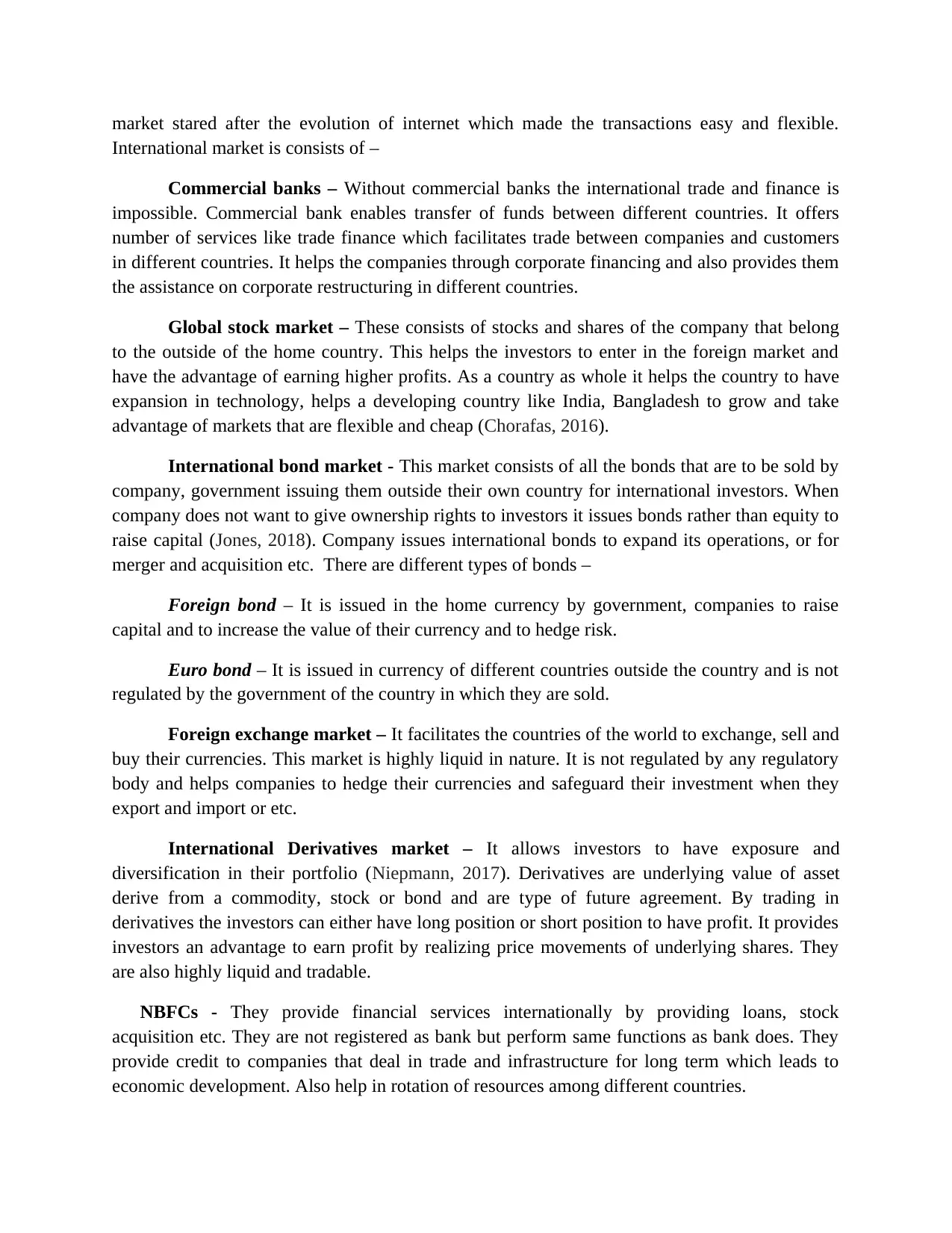
market stared after the evolution of internet which made the transactions easy and flexible.
International market is consists of –
Commercial banks – Without commercial banks the international trade and finance is
impossible. Commercial bank enables transfer of funds between different countries. It offers
number of services like trade finance which facilitates trade between companies and customers
in different countries. It helps the companies through corporate financing and also provides them
the assistance on corporate restructuring in different countries.
Global stock market – These consists of stocks and shares of the company that belong
to the outside of the home country. This helps the investors to enter in the foreign market and
have the advantage of earning higher profits. As a country as whole it helps the country to have
expansion in technology, helps a developing country like India, Bangladesh to grow and take
advantage of markets that are flexible and cheap (Chorafas, 2016).
International bond market - This market consists of all the bonds that are to be sold by
company, government issuing them outside their own country for international investors. When
company does not want to give ownership rights to investors it issues bonds rather than equity to
raise capital (Jones, 2018). Company issues international bonds to expand its operations, or for
merger and acquisition etc. There are different types of bonds –
Foreign bond – It is issued in the home currency by government, companies to raise
capital and to increase the value of their currency and to hedge risk.
Euro bond – It is issued in currency of different countries outside the country and is not
regulated by the government of the country in which they are sold.
Foreign exchange market – It facilitates the countries of the world to exchange, sell and
buy their currencies. This market is highly liquid in nature. It is not regulated by any regulatory
body and helps companies to hedge their currencies and safeguard their investment when they
export and import or etc.
International Derivatives market – It allows investors to have exposure and
diversification in their portfolio (Niepmann, 2017). Derivatives are underlying value of asset
derive from a commodity, stock or bond and are type of future agreement. By trading in
derivatives the investors can either have long position or short position to have profit. It provides
investors an advantage to earn profit by realizing price movements of underlying shares. They
are also highly liquid and tradable.
NBFCs - They provide financial services internationally by providing loans, stock
acquisition etc. They are not registered as bank but perform same functions as bank does. They
provide credit to companies that deal in trade and infrastructure for long term which leads to
economic development. Also help in rotation of resources among different countries.
International market is consists of –
Commercial banks – Without commercial banks the international trade and finance is
impossible. Commercial bank enables transfer of funds between different countries. It offers
number of services like trade finance which facilitates trade between companies and customers
in different countries. It helps the companies through corporate financing and also provides them
the assistance on corporate restructuring in different countries.
Global stock market – These consists of stocks and shares of the company that belong
to the outside of the home country. This helps the investors to enter in the foreign market and
have the advantage of earning higher profits. As a country as whole it helps the country to have
expansion in technology, helps a developing country like India, Bangladesh to grow and take
advantage of markets that are flexible and cheap (Chorafas, 2016).
International bond market - This market consists of all the bonds that are to be sold by
company, government issuing them outside their own country for international investors. When
company does not want to give ownership rights to investors it issues bonds rather than equity to
raise capital (Jones, 2018). Company issues international bonds to expand its operations, or for
merger and acquisition etc. There are different types of bonds –
Foreign bond – It is issued in the home currency by government, companies to raise
capital and to increase the value of their currency and to hedge risk.
Euro bond – It is issued in currency of different countries outside the country and is not
regulated by the government of the country in which they are sold.
Foreign exchange market – It facilitates the countries of the world to exchange, sell and
buy their currencies. This market is highly liquid in nature. It is not regulated by any regulatory
body and helps companies to hedge their currencies and safeguard their investment when they
export and import or etc.
International Derivatives market – It allows investors to have exposure and
diversification in their portfolio (Niepmann, 2017). Derivatives are underlying value of asset
derive from a commodity, stock or bond and are type of future agreement. By trading in
derivatives the investors can either have long position or short position to have profit. It provides
investors an advantage to earn profit by realizing price movements of underlying shares. They
are also highly liquid and tradable.
NBFCs - They provide financial services internationally by providing loans, stock
acquisition etc. They are not registered as bank but perform same functions as bank does. They
provide credit to companies that deal in trade and infrastructure for long term which leads to
economic development. Also help in rotation of resources among different countries.
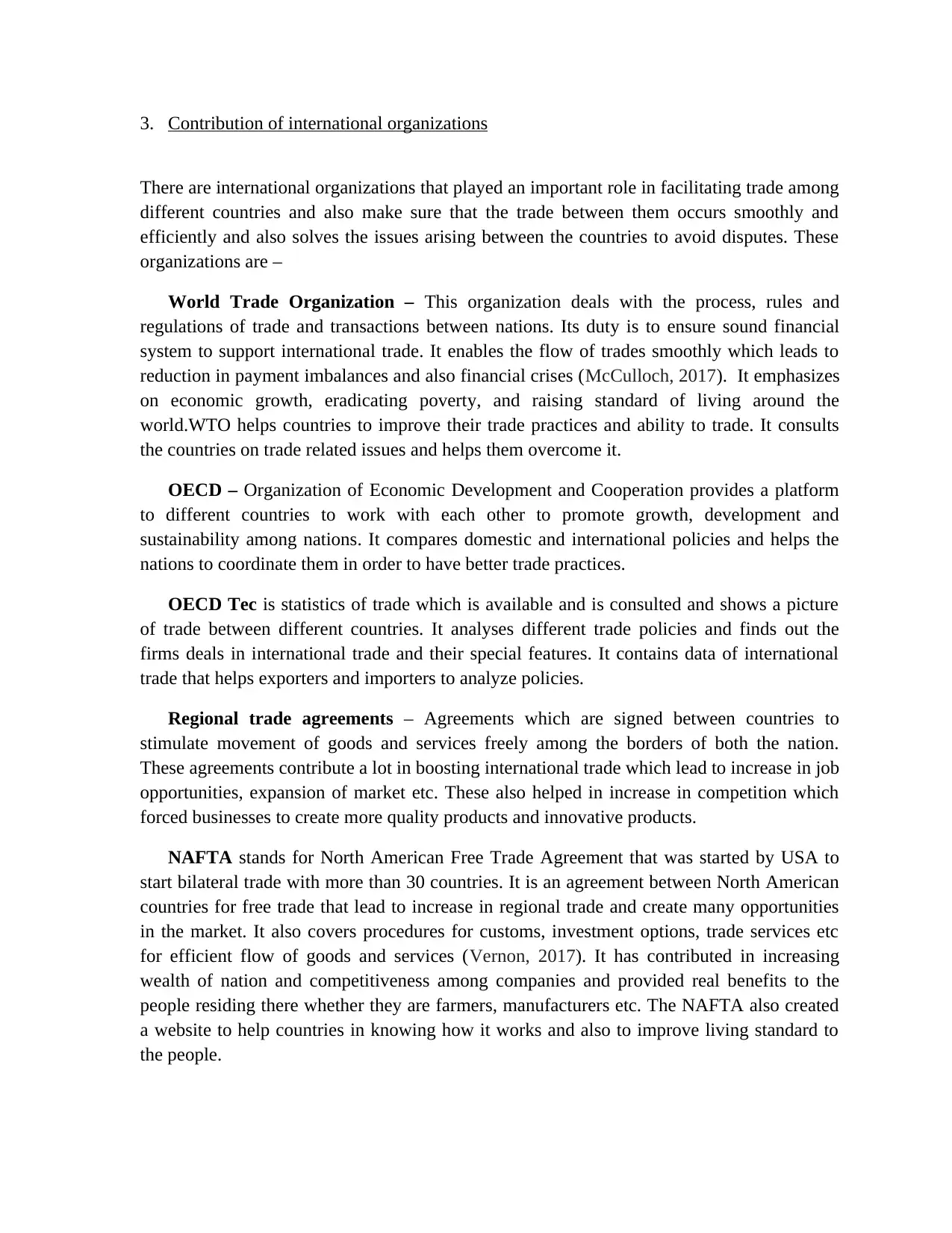
3. Contribution of international organizations
There are international organizations that played an important role in facilitating trade among
different countries and also make sure that the trade between them occurs smoothly and
efficiently and also solves the issues arising between the countries to avoid disputes. These
organizations are –
World Trade Organization – This organization deals with the process, rules and
regulations of trade and transactions between nations. Its duty is to ensure sound financial
system to support international trade. It enables the flow of trades smoothly which leads to
reduction in payment imbalances and also financial crises (McCulloch, 2017). It emphasizes
on economic growth, eradicating poverty, and raising standard of living around the
world.WTO helps countries to improve their trade practices and ability to trade. It consults
the countries on trade related issues and helps them overcome it.
OECD – Organization of Economic Development and Cooperation provides a platform
to different countries to work with each other to promote growth, development and
sustainability among nations. It compares domestic and international policies and helps the
nations to coordinate them in order to have better trade practices.
OECD Tec is statistics of trade which is available and is consulted and shows a picture
of trade between different countries. It analyses different trade policies and finds out the
firms deals in international trade and their special features. It contains data of international
trade that helps exporters and importers to analyze policies.
Regional trade agreements – Agreements which are signed between countries to
stimulate movement of goods and services freely among the borders of both the nation.
These agreements contribute a lot in boosting international trade which lead to increase in job
opportunities, expansion of market etc. These also helped in increase in competition which
forced businesses to create more quality products and innovative products.
NAFTA stands for North American Free Trade Agreement that was started by USA to
start bilateral trade with more than 30 countries. It is an agreement between North American
countries for free trade that lead to increase in regional trade and create many opportunities
in the market. It also covers procedures for customs, investment options, trade services etc
for efficient flow of goods and services (Vernon, 2017). It has contributed in increasing
wealth of nation and competitiveness among companies and provided real benefits to the
people residing there whether they are farmers, manufacturers etc. The NAFTA also created
a website to help countries in knowing how it works and also to improve living standard to
the people.
There are international organizations that played an important role in facilitating trade among
different countries and also make sure that the trade between them occurs smoothly and
efficiently and also solves the issues arising between the countries to avoid disputes. These
organizations are –
World Trade Organization – This organization deals with the process, rules and
regulations of trade and transactions between nations. Its duty is to ensure sound financial
system to support international trade. It enables the flow of trades smoothly which leads to
reduction in payment imbalances and also financial crises (McCulloch, 2017). It emphasizes
on economic growth, eradicating poverty, and raising standard of living around the
world.WTO helps countries to improve their trade practices and ability to trade. It consults
the countries on trade related issues and helps them overcome it.
OECD – Organization of Economic Development and Cooperation provides a platform
to different countries to work with each other to promote growth, development and
sustainability among nations. It compares domestic and international policies and helps the
nations to coordinate them in order to have better trade practices.
OECD Tec is statistics of trade which is available and is consulted and shows a picture
of trade between different countries. It analyses different trade policies and finds out the
firms deals in international trade and their special features. It contains data of international
trade that helps exporters and importers to analyze policies.
Regional trade agreements – Agreements which are signed between countries to
stimulate movement of goods and services freely among the borders of both the nation.
These agreements contribute a lot in boosting international trade which lead to increase in job
opportunities, expansion of market etc. These also helped in increase in competition which
forced businesses to create more quality products and innovative products.
NAFTA stands for North American Free Trade Agreement that was started by USA to
start bilateral trade with more than 30 countries. It is an agreement between North American
countries for free trade that lead to increase in regional trade and create many opportunities
in the market. It also covers procedures for customs, investment options, trade services etc
for efficient flow of goods and services (Vernon, 2017). It has contributed in increasing
wealth of nation and competitiveness among companies and provided real benefits to the
people residing there whether they are farmers, manufacturers etc. The NAFTA also created
a website to help countries in knowing how it works and also to improve living standard to
the people.
⊘ This is a preview!⊘
Do you want full access?
Subscribe today to unlock all pages.

Trusted by 1+ million students worldwide
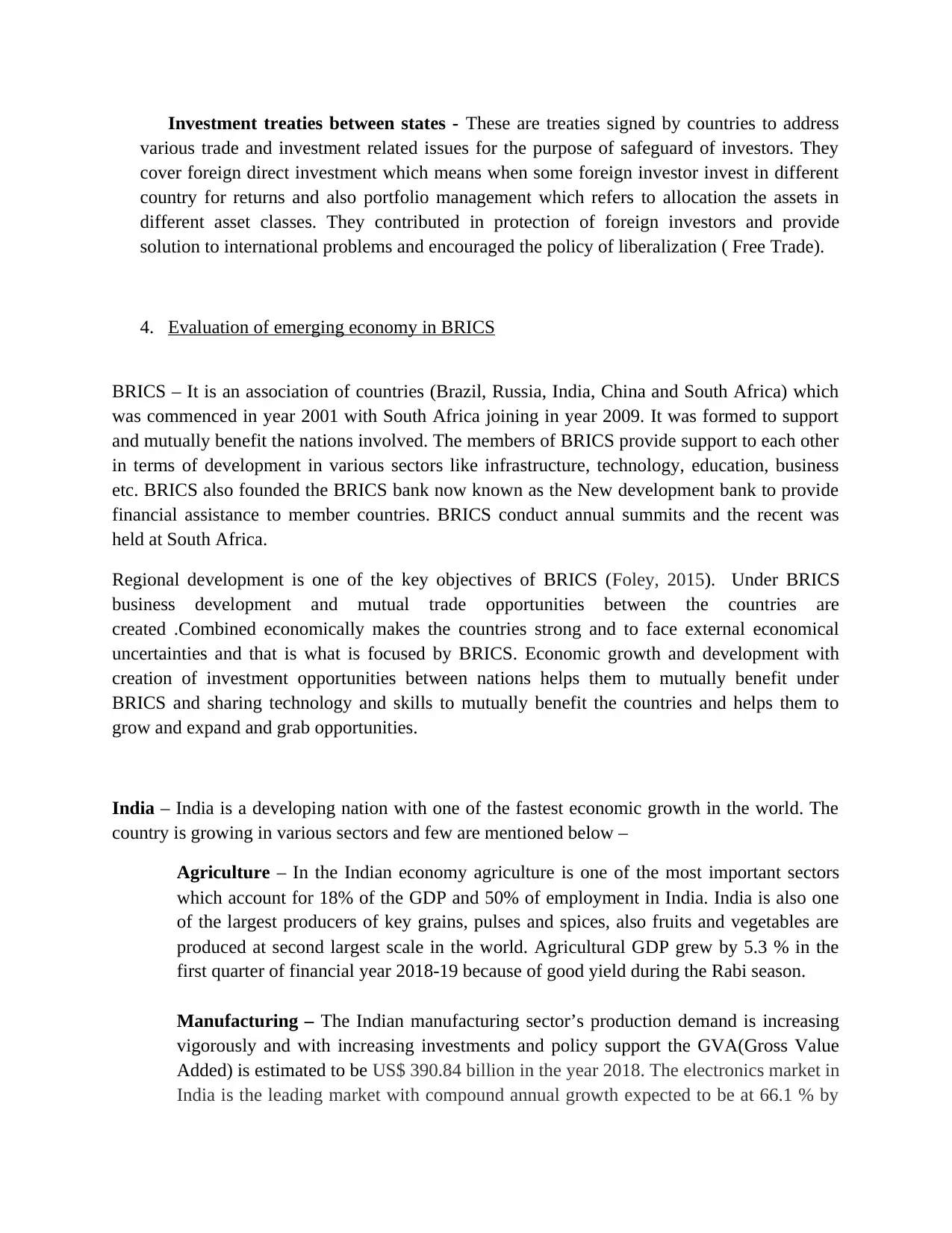
Investment treaties between states - These are treaties signed by countries to address
various trade and investment related issues for the purpose of safeguard of investors. They
cover foreign direct investment which means when some foreign investor invest in different
country for returns and also portfolio management which refers to allocation the assets in
different asset classes. They contributed in protection of foreign investors and provide
solution to international problems and encouraged the policy of liberalization ( Free Trade).
4. Evaluation of emerging economy in BRICS
BRICS – It is an association of countries (Brazil, Russia, India, China and South Africa) which
was commenced in year 2001 with South Africa joining in year 2009. It was formed to support
and mutually benefit the nations involved. The members of BRICS provide support to each other
in terms of development in various sectors like infrastructure, technology, education, business
etc. BRICS also founded the BRICS bank now known as the New development bank to provide
financial assistance to member countries. BRICS conduct annual summits and the recent was
held at South Africa.
Regional development is one of the key objectives of BRICS (Foley, 2015). Under BRICS
business development and mutual trade opportunities between the countries are
created .Combined economically makes the countries strong and to face external economical
uncertainties and that is what is focused by BRICS. Economic growth and development with
creation of investment opportunities between nations helps them to mutually benefit under
BRICS and sharing technology and skills to mutually benefit the countries and helps them to
grow and expand and grab opportunities.
India – India is a developing nation with one of the fastest economic growth in the world. The
country is growing in various sectors and few are mentioned below –
Agriculture – In the Indian economy agriculture is one of the most important sectors
which account for 18% of the GDP and 50% of employment in India. India is also one
of the largest producers of key grains, pulses and spices, also fruits and vegetables are
produced at second largest scale in the world. Agricultural GDP grew by 5.3 % in the
first quarter of financial year 2018-19 because of good yield during the Rabi season.
Manufacturing – The Indian manufacturing sector’s production demand is increasing
vigorously and with increasing investments and policy support the GVA(Gross Value
Added) is estimated to be US$ 390.84 billion in the year 2018. The electronics market in
India is the leading market with compound annual growth expected to be at 66.1 % by
various trade and investment related issues for the purpose of safeguard of investors. They
cover foreign direct investment which means when some foreign investor invest in different
country for returns and also portfolio management which refers to allocation the assets in
different asset classes. They contributed in protection of foreign investors and provide
solution to international problems and encouraged the policy of liberalization ( Free Trade).
4. Evaluation of emerging economy in BRICS
BRICS – It is an association of countries (Brazil, Russia, India, China and South Africa) which
was commenced in year 2001 with South Africa joining in year 2009. It was formed to support
and mutually benefit the nations involved. The members of BRICS provide support to each other
in terms of development in various sectors like infrastructure, technology, education, business
etc. BRICS also founded the BRICS bank now known as the New development bank to provide
financial assistance to member countries. BRICS conduct annual summits and the recent was
held at South Africa.
Regional development is one of the key objectives of BRICS (Foley, 2015). Under BRICS
business development and mutual trade opportunities between the countries are
created .Combined economically makes the countries strong and to face external economical
uncertainties and that is what is focused by BRICS. Economic growth and development with
creation of investment opportunities between nations helps them to mutually benefit under
BRICS and sharing technology and skills to mutually benefit the countries and helps them to
grow and expand and grab opportunities.
India – India is a developing nation with one of the fastest economic growth in the world. The
country is growing in various sectors and few are mentioned below –
Agriculture – In the Indian economy agriculture is one of the most important sectors
which account for 18% of the GDP and 50% of employment in India. India is also one
of the largest producers of key grains, pulses and spices, also fruits and vegetables are
produced at second largest scale in the world. Agricultural GDP grew by 5.3 % in the
first quarter of financial year 2018-19 because of good yield during the Rabi season.
Manufacturing – The Indian manufacturing sector’s production demand is increasing
vigorously and with increasing investments and policy support the GVA(Gross Value
Added) is estimated to be US$ 390.84 billion in the year 2018. The electronics market in
India is the leading market with compound annual growth expected to be at 66.1 % by
Paraphrase This Document
Need a fresh take? Get an instant paraphrase of this document with our AI Paraphraser
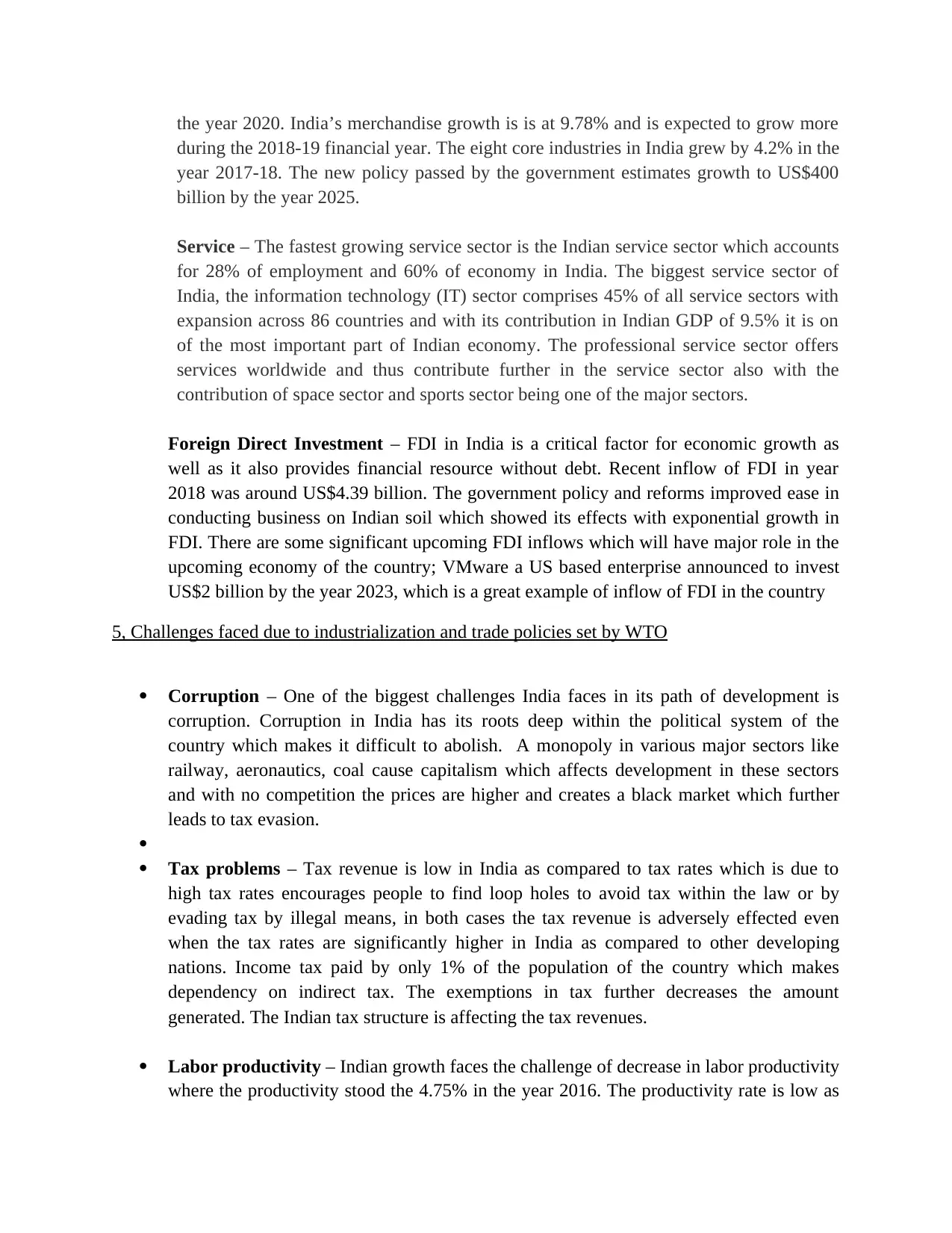
the year 2020. India’s merchandise growth is is at 9.78% and is expected to grow more
during the 2018-19 financial year. The eight core industries in India grew by 4.2% in the
year 2017-18. The new policy passed by the government estimates growth to US$400
billion by the year 2025.
Service – The fastest growing service sector is the Indian service sector which accounts
for 28% of employment and 60% of economy in India. The biggest service sector of
India, the information technology (IT) sector comprises 45% of all service sectors with
expansion across 86 countries and with its contribution in Indian GDP of 9.5% it is on
of the most important part of Indian economy. The professional service sector offers
services worldwide and thus contribute further in the service sector also with the
contribution of space sector and sports sector being one of the major sectors.
Foreign Direct Investment – FDI in India is a critical factor for economic growth as
well as it also provides financial resource without debt. Recent inflow of FDI in year
2018 was around US$4.39 billion. The government policy and reforms improved ease in
conducting business on Indian soil which showed its effects with exponential growth in
FDI. There are some significant upcoming FDI inflows which will have major role in the
upcoming economy of the country; VMware a US based enterprise announced to invest
US$2 billion by the year 2023, which is a great example of inflow of FDI in the country
5, Challenges faced due to industrialization and trade policies set by WTO
Corruption – One of the biggest challenges India faces in its path of development is
corruption. Corruption in India has its roots deep within the political system of the
country which makes it difficult to abolish. A monopoly in various major sectors like
railway, aeronautics, coal cause capitalism which affects development in these sectors
and with no competition the prices are higher and creates a black market which further
leads to tax evasion.
Tax problems – Tax revenue is low in India as compared to tax rates which is due to
high tax rates encourages people to find loop holes to avoid tax within the law or by
evading tax by illegal means, in both cases the tax revenue is adversely effected even
when the tax rates are significantly higher in India as compared to other developing
nations. Income tax paid by only 1% of the population of the country which makes
dependency on indirect tax. The exemptions in tax further decreases the amount
generated. The Indian tax structure is affecting the tax revenues.
Labor productivity – Indian growth faces the challenge of decrease in labor productivity
where the productivity stood the 4.75% in the year 2016. The productivity rate is low as
during the 2018-19 financial year. The eight core industries in India grew by 4.2% in the
year 2017-18. The new policy passed by the government estimates growth to US$400
billion by the year 2025.
Service – The fastest growing service sector is the Indian service sector which accounts
for 28% of employment and 60% of economy in India. The biggest service sector of
India, the information technology (IT) sector comprises 45% of all service sectors with
expansion across 86 countries and with its contribution in Indian GDP of 9.5% it is on
of the most important part of Indian economy. The professional service sector offers
services worldwide and thus contribute further in the service sector also with the
contribution of space sector and sports sector being one of the major sectors.
Foreign Direct Investment – FDI in India is a critical factor for economic growth as
well as it also provides financial resource without debt. Recent inflow of FDI in year
2018 was around US$4.39 billion. The government policy and reforms improved ease in
conducting business on Indian soil which showed its effects with exponential growth in
FDI. There are some significant upcoming FDI inflows which will have major role in the
upcoming economy of the country; VMware a US based enterprise announced to invest
US$2 billion by the year 2023, which is a great example of inflow of FDI in the country
5, Challenges faced due to industrialization and trade policies set by WTO
Corruption – One of the biggest challenges India faces in its path of development is
corruption. Corruption in India has its roots deep within the political system of the
country which makes it difficult to abolish. A monopoly in various major sectors like
railway, aeronautics, coal cause capitalism which affects development in these sectors
and with no competition the prices are higher and creates a black market which further
leads to tax evasion.
Tax problems – Tax revenue is low in India as compared to tax rates which is due to
high tax rates encourages people to find loop holes to avoid tax within the law or by
evading tax by illegal means, in both cases the tax revenue is adversely effected even
when the tax rates are significantly higher in India as compared to other developing
nations. Income tax paid by only 1% of the population of the country which makes
dependency on indirect tax. The exemptions in tax further decreases the amount
generated. The Indian tax structure is affecting the tax revenues.
Labor productivity – Indian growth faces the challenge of decrease in labor productivity
where the productivity stood the 4.75% in the year 2016. The productivity rate is low as
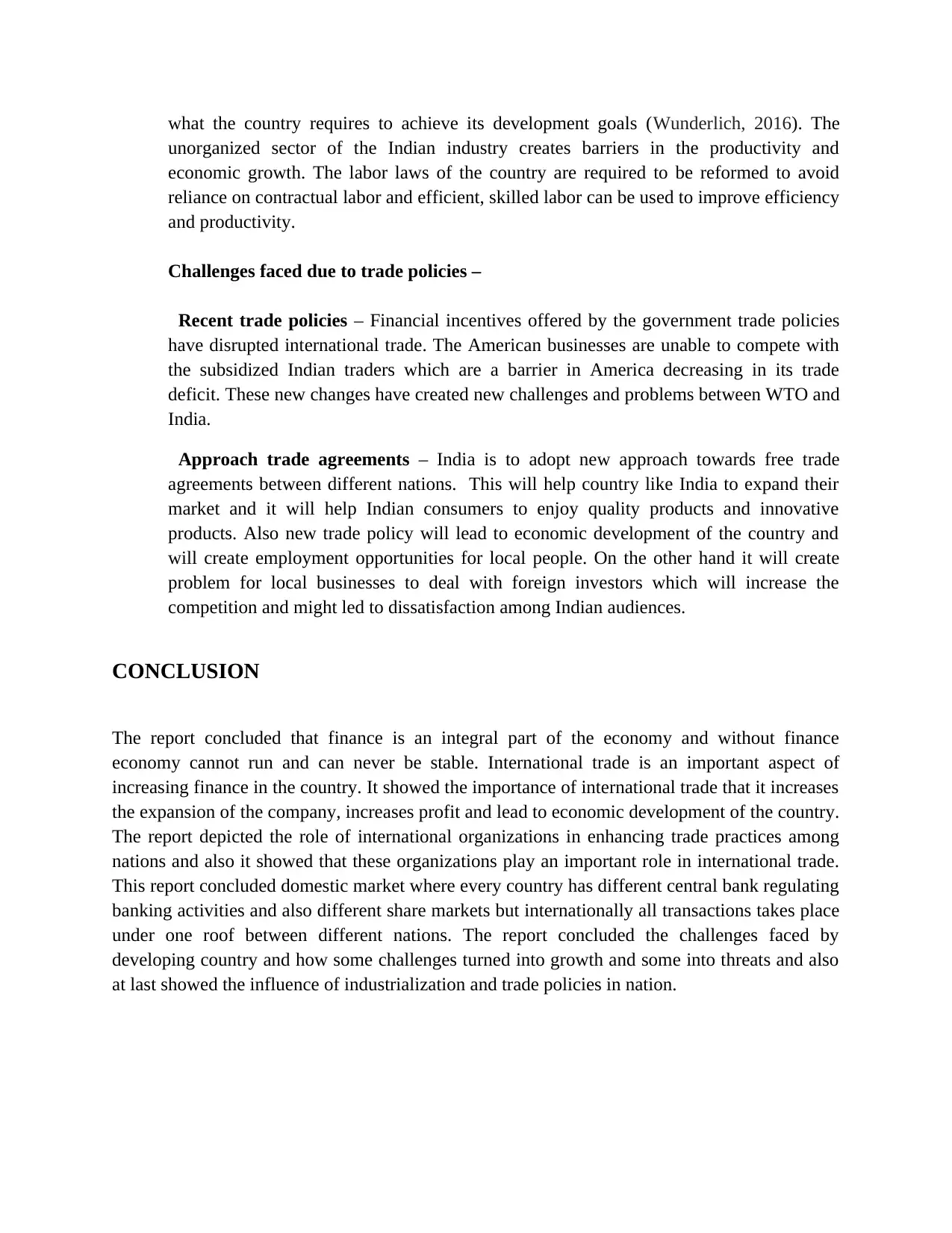
what the country requires to achieve its development goals (Wunderlich, 2016). The
unorganized sector of the Indian industry creates barriers in the productivity and
economic growth. The labor laws of the country are required to be reformed to avoid
reliance on contractual labor and efficient, skilled labor can be used to improve efficiency
and productivity.
Challenges faced due to trade policies –
Recent trade policies – Financial incentives offered by the government trade policies
have disrupted international trade. The American businesses are unable to compete with
the subsidized Indian traders which are a barrier in America decreasing in its trade
deficit. These new changes have created new challenges and problems between WTO and
India.
Approach trade agreements – India is to adopt new approach towards free trade
agreements between different nations. This will help country like India to expand their
market and it will help Indian consumers to enjoy quality products and innovative
products. Also new trade policy will lead to economic development of the country and
will create employment opportunities for local people. On the other hand it will create
problem for local businesses to deal with foreign investors which will increase the
competition and might led to dissatisfaction among Indian audiences.
CONCLUSION
The report concluded that finance is an integral part of the economy and without finance
economy cannot run and can never be stable. International trade is an important aspect of
increasing finance in the country. It showed the importance of international trade that it increases
the expansion of the company, increases profit and lead to economic development of the country.
The report depicted the role of international organizations in enhancing trade practices among
nations and also it showed that these organizations play an important role in international trade.
This report concluded domestic market where every country has different central bank regulating
banking activities and also different share markets but internationally all transactions takes place
under one roof between different nations. The report concluded the challenges faced by
developing country and how some challenges turned into growth and some into threats and also
at last showed the influence of industrialization and trade policies in nation.
unorganized sector of the Indian industry creates barriers in the productivity and
economic growth. The labor laws of the country are required to be reformed to avoid
reliance on contractual labor and efficient, skilled labor can be used to improve efficiency
and productivity.
Challenges faced due to trade policies –
Recent trade policies – Financial incentives offered by the government trade policies
have disrupted international trade. The American businesses are unable to compete with
the subsidized Indian traders which are a barrier in America decreasing in its trade
deficit. These new changes have created new challenges and problems between WTO and
India.
Approach trade agreements – India is to adopt new approach towards free trade
agreements between different nations. This will help country like India to expand their
market and it will help Indian consumers to enjoy quality products and innovative
products. Also new trade policy will lead to economic development of the country and
will create employment opportunities for local people. On the other hand it will create
problem for local businesses to deal with foreign investors which will increase the
competition and might led to dissatisfaction among Indian audiences.
CONCLUSION
The report concluded that finance is an integral part of the economy and without finance
economy cannot run and can never be stable. International trade is an important aspect of
increasing finance in the country. It showed the importance of international trade that it increases
the expansion of the company, increases profit and lead to economic development of the country.
The report depicted the role of international organizations in enhancing trade practices among
nations and also it showed that these organizations play an important role in international trade.
This report concluded domestic market where every country has different central bank regulating
banking activities and also different share markets but internationally all transactions takes place
under one roof between different nations. The report concluded the challenges faced by
developing country and how some challenges turned into growth and some into threats and also
at last showed the influence of industrialization and trade policies in nation.
⊘ This is a preview!⊘
Do you want full access?
Subscribe today to unlock all pages.

Trusted by 1+ million students worldwide
1 out of 15
Related Documents
Your All-in-One AI-Powered Toolkit for Academic Success.
+13062052269
info@desklib.com
Available 24*7 on WhatsApp / Email
![[object Object]](/_next/static/media/star-bottom.7253800d.svg)
Unlock your academic potential
Copyright © 2020–2025 A2Z Services. All Rights Reserved. Developed and managed by ZUCOL.





